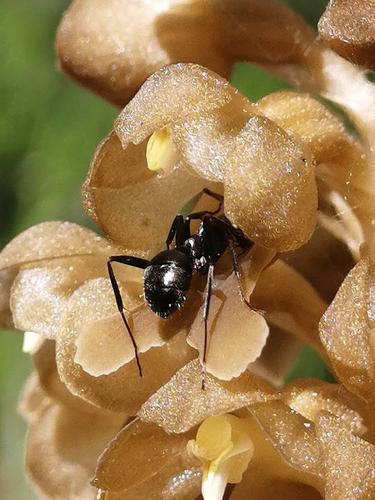Journal of Ecology ( IF 5.5 ) Pub Date : 2022-06-17 , DOI: 10.1111/1365-2745.13953 Jana Jersáková 1 , Julita Minasiewicz 2 , Marc‐André Selosse 2, 3

|
Bird's-nest Orchid. Orchidaceae, subfamily Epidendroideae, tribe Neottieae. Neottia nidus-avis is a perennial, non-photosynthetic, mycoheterotrophic herb, with short subterranean rhizomes.
Rhizome up to 5–6 cm long, 2–5 mm in diameter, developing one rapidly decaying scale-leaf with axillary bud each year. Rhizome densely covered by numerous (20-)50–80(−120) fleshy adventitious roots. Adventitious roots 1.5–4 cm long and 1–4 mm in diameter, all of similar limited length forming a tangled mass reminiscent of a bird's nest. From this it derives both its generic and specific Latin names (from neotteia, nest in Greek, and nidus-avis, nest of a bird in Latin) as well as names in many other languages (see 10).
Flowering shoot (15)20–40(60) cm high, 3–7 mm wide at the base, solitary or occasionally with two or more shoots from the same rhizome, erect, fairly robust, yellowish-brown and slightly glandular-hairy towards the tip. Green leaves are absent, but the lower part of the shoot is sheathed by 3–5 scale-like, yellowish-brown leaves; scale-leaves lanceolate, the upper ones longer and blunter, surrounding the shoot bud and probably protecting the flowering shoot during subsequent growth.
Inflorescence a spike, c. 10–20 cm, cylindrical and dense-flowered above, less so below, with up to 100 flowers in large plants. Bracts 4–8 mm, lanceolate, tapering to an acute apex, papery and roughly as long as the ovary and pedicel together. Flower 15 mm, yellowish-brown, with a honey-like scent. Sepals and petals 4–6 mm long and 3–4 mm wide, oval-spatulate, forming a loose fan-shaped hood over the column. Labellum 10–12 mm, brown, directed forward, hollowed into a nectar-containing cup at the base and divided distally into two broad, spreading lateral lobes, also sometimes with a subtle point or tooth on either side of the lip halfway towards the base. Spur absent. Column cylindrical, pale brownish-white, with an oblong, papillose anther on the outside. Rostellum leaf-like, concave on the upper side, forming a clinandrium in which the pollinia rest after they fall out of the anther at anthesis. Stigma positioned in front of the column, appearing V-shaped, running either side of the rostellum. Pollinia two, pale yellow, linear-oblong, each consisting of two halves containing loosely connected powdery pollen grains united in tetrads, projecting conspicuously from beneath the anther cap. Ovary ovate, 10 mm, subtly six-ribbed with glandular hairs and held on a twisted stalk that is about half the length of the ovary.
Neottia comprises 63 autotrophic and mycoheterotrophic terrestrial species distributed throughout the northern hemisphere, from temperate to arctic habitats (Pridgeon et al., 2005). Formerly, the genus included only non-photosynthetic taxa, but the long-noted similarity between species belonging to Neottia and Listera, based on generative structures (Dressler, 1990), has been confirmed by DNA-based phylogenetic classification (Chase et al., 2003; Chase et al., 2015; Zhou & Jin, 2018), leading to the recent expansion of the genus Neottia to include photosynthetic species of Listera.
Neottia nidus-avis displays several morphological variations, although with little taxonomical value (Prochazka, 1980). Plants with numerous glandular hairs on the inflorescence axis, ovary and pedicels were described as var. glandulosa Beck 1890, while the nominate variety (var. nidus-avis, or var. typica Beck) is glabrous; f. dilatata Zapał 1906 has smaller flowers and outer perianth segments only 4–5 mm long; f. brunnea Weiss (f. macrostelis Petrm.) has large outer perianth segments 5–7 mm long; f. brachystellis Peterm. is has the stylar part of column shorter than anther. Colour variation led to a description of var. pallida Wirtg. with a yellow-whitish stem and flowers and white pollinia, var. nivea Magnus ex Schulze for white plants (that lack the traces of chlorophyll and carotenoid pigments normally present, see 6.5) and var. sulphurea Ascherson and Graebner for sulphur-yellow plants (see Lewis, 2018).
Neottia nidus-avis is a native mycoheterotrophic orchid, typically inhabiting the dense shade of old, broadleaved (usually beech) woodlands. Although still widespread and locally abundant in the British Isles, it has suffered a considerable decline with shrinking habitat availability and quality throughout the 20th century, especially in south-eastern and central England.
中文翻译:

不列颠和爱尔兰的生物植物群:Neottia nidus-avis
燕窝兰花。兰科,Epidendroideae 亚科,Neottieae 部落。Neottia nidus-avis是一种多年生、非光合作用、真菌异养草本植物,具有短的地下根茎。
根状茎长可达5-6厘米,直径2-5毫米,每年发育1片快速腐烂的鳞片叶,有腋芽。根状茎密被许多 (20-)50-80(-120) 肉质不定根。不定根长 1.5-4 厘米,直径 1-4 毫米,长度有限,形成一个缠结的团块,让人联想到燕窝。它由此衍生出其通用和特定的拉丁名称(来自neotteia,希腊语中的nest,和nidus-avis,拉丁语中的鸟巢)以及许多其他语言中的名称(参见10)。
开花芽 (15)20-40(60) 厘米高,基部宽 3-7 毫米,单生或偶尔从同一根茎上生出两个或多个芽,直立,相当粗壮,黄褐色,稍具腺毛小费。无绿叶,但枝条下部有3-5片鳞片状黄褐色叶子;鳞叶披针形,上部较长且较钝,围绕着芽芽,可能在随后的生长过程中保护开花芽。
花序a穗,c. 10-20厘米,圆柱形,上面开花密集,下面较少,大株有多达100朵花。苞片4-8毫米,披针形,逐渐变细至锐尖,纸质,大致与子房和花梗等长。花15毫米,黄褐色,有蜂蜜味。萼片和花瓣长4-6毫米,宽3-4毫米,椭圆形匙形,在柱子上形成一个松散的扇形罩。唇瓣长 10-12 毫米,棕色,向前,在基部挖空成一个含花蜜的杯状体,向远侧分成两个宽阔、展开的侧裂片,有时在唇部两侧朝基部的中间有一个细微的尖端或牙齿. 马刺缺席。柱圆柱状,淡棕白色,外面有一长圆形,具乳突状花药。Rostellum 叶状,上侧凹入,在花期从花药中脱落后,花粉粒在其中休息。柱头位于柱的前面,呈 V 形,分布在前突的两侧。Pollinia 2,淡黄色,线形长圆形,每个由两半组成,含有松散连接的粉状花粉粒,结合成四分体,从花药帽下方显着突出。子房卵形,长10毫米,略具六棱,具腺毛,长于约子房长度一半的扭曲柄上。
Neotia包括 63 种自养和真菌异养陆地物种,分布在整个北半球,从温带到北极栖息地(Pridgeon 等人, 2005 年)。以前,该属仅包括非光合类群,但基于生殖结构(Dressler, 1990 ),属于新奥蒂亚属和李斯特菌属的物种之间长期存在的相似性已通过基于 DNA 的系统发育分类得到证实(Chase 等人, 2003 年;Chase 等人, 2015 年;Zhou 和 Jin, 2018 年),导致最近将新蝶属属扩大到包括李斯特菌的光合物种。
Neottia nidus-avis表现出多种形态变异,尽管分类价值很小(Prochazka, 1980 年)。花序轴、子房和花梗上有许多腺毛的植物被描述为var。腺体贝克 1890,而指名品种(var. nidus-avis或 var. typica Beck)是无毛的;F。dilatata Zapał 1906 花较小,外花被片仅 4-5 毫米长;F。brunnea Weiss (f. macrostelis Petrm.) 具有 5-7 毫米长的大外花被片;F。短柄草属彼得姆。是柱的花柱部分比花药短。颜色变化导致了对 var 的描述。苍白的Wirtg。有黄白色的茎和花和白色花粉,变种。nivea Magnus ex Schulze 用于白色植物(缺乏通常存在的叶绿素和类胡萝卜素色素,见 6.5)和 var。sulphurea Ascherson 和 Graebner 用于硫黄植物(参见 Lewis, 2018 年)。
Neottia nidus-avis是一种原生的真菌异养兰花,通常栖息在古老的阔叶(通常是山毛榉)林地的茂密树荫下。尽管在不列颠群岛仍然分布广泛且当地丰富,但在整个 20 世纪,尤其是在英格兰东南部和中部,随着栖息地可用性和质量的下降,它已经遭受了相当大的衰退。



























 京公网安备 11010802027423号
京公网安备 11010802027423号